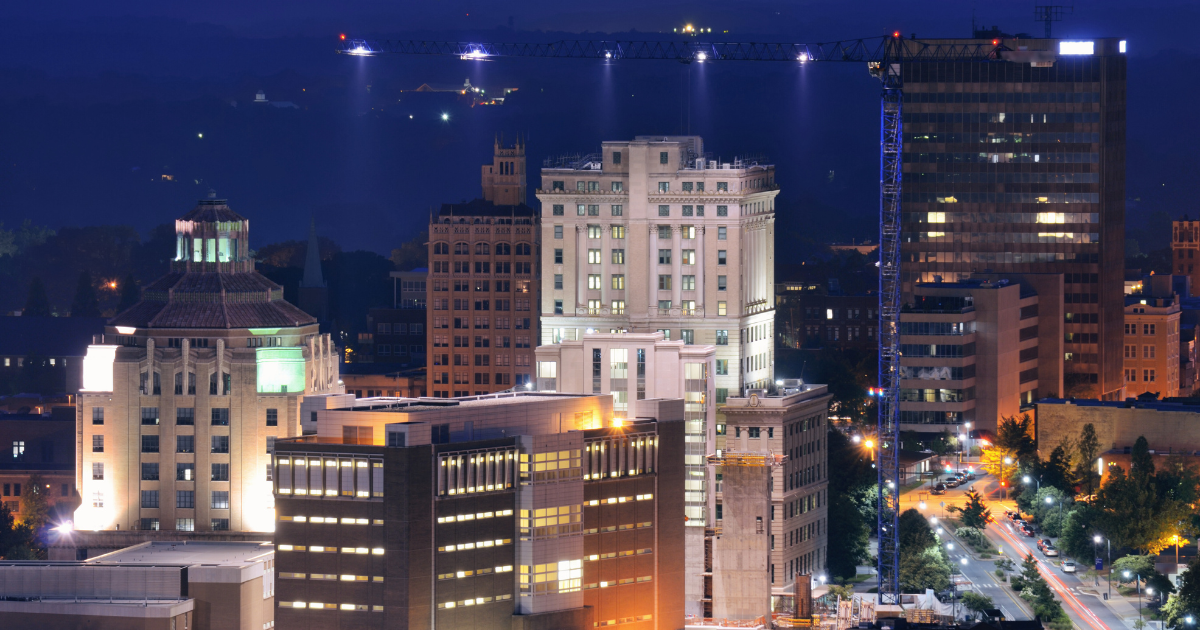Sure, everyone says Asheville is "nestled" in the Blue Ridge Mountains. And yes, it's officially the most overused word in mountain town marketing - but there's a reason we keep using it. Asheville has become one of the most sought-after destinations for transplants seeking natural beauty, cultural vibrancy, and economic opportunity. From tech professionals escaping big-city stress to retirees drawn by the area's charm and outdoor recreation, people from across the country are discovering what locals have known for years: Asheville offers an unmatched quality of life.
The city's population has grown steadily over the past decade, fueled by remote work flexibility, a thriving craft beer scene, world-class hiking trails, and a cost of living that remains more reasonable than many comparable mountain towns out west. Add in a flourishing arts community, farm-to-table dining culture, and the magnetic pull of the Appalachian Mountains, and it's easy to see why Asheville consistently ranks among the best places to live in the Southeast.
But with growth comes change, and savvy newcomers are looking beyond the obvious choices to find neighborhoods that offer both current appeal and future potential. Here are the top five neighborhoods in Asheville that are capturing attention and investment in 2025.
1. River Arts District (RAD)
Once an industrial corridor along the French Broad River, the River Arts District has transformed into Asheville's creative epicenter. This area embodies the city's artistic soul, and its remarkable resilience in the face of adversity has only strengthened its appeal as one of the most compelling places to invest and live in 2025.
Hurricane Helene brought devastating flooding to the RAD in September 2024, with the French Broad River rising to historic levels and damaging many of the converted warehouses and industrial spaces that housed over 200 artists. Studios filled with decades of artwork were lost, businesses were forced to close, and the community faced an uncertain future. However, what emerged from this tragedy was a testament to the unbreakable spirit of Asheville's creative community.
The rebuilding effort has been nothing short of extraordinary. Artists, residents, and supporters from across the country rallied to help restore the district, with crowdfunding campaigns raising millions of dollars and volunteers working tirelessly to help artists salvage what they could and rebuild their studios. The community support has been overwhelming, demonstrating that the RAD isn't just a place - it's a movement that people believe in preserving and strengthening.
The neighborhood continues to appeal to young professionals, artists, and anyone seeking an authentic Asheville experience. The resilience shown by the RAD community, combined with the ongoing support from both local and national supporters, ensures that this creative district will not only recover but thrive in ways that honor both its artistic heritage and its demonstrated strength in the face of adversity.
2. South Slope
Sitting just south of downtown Asheville, South Slope has emerged as the city's beer district and a hub for young professionals and entrepreneurs. This compact neighborhood packs an impressive concentration of breweries, restaurants, and entertainment venues into a highly walkable area.
South Slope is home to iconic Asheville breweries like Wicked Weed, Green Man, and Burial, making it a pilgrimage destination for craft beer enthusiasts. The neighborhood's industrial buildings have been creatively repurposed into breweries, event spaces, and mixed-use developments. The area also boasts excellent restaurants, from casual taquerias to upscale farm-to-table establishments.
The real estate market in South Slope reflects its growing popularity, with new condo developments and converted lofts commanding premium prices. The neighborhood's proximity to downtown, combined with its own distinct identity, makes it attractive to buyers who want urban amenities without sacrificing character.
Looking ahead to 2025, South Slope is positioned for continued growth as more businesses move in and residential options expand. The planned improvements to pedestrian infrastructure will make the area even more walkable, potentially driving property values higher. For those seeking a dynamic neighborhood with nightlife, dining, and convenience, South Slope offers an urban mountain town experience unlike anywhere else in Asheville.
3. West Asheville
Separated from downtown by the French Broad River, West Asheville has developed its own distinct personality as a more laid-back, family-friendly alternative to the busier east side of the city. This neighborhood has been quietly growing in popularity, offering an eclectic mix of residential charm and local businesses.
West Asheville's main corridor, Haywood Road, features a unique mix of vintage shops, local restaurants, coffee houses, and bars. The area has a strong sense of community, with regular events like the monthly Tailgate Market and various neighborhood events. The residential streets are lined with everything from historic bungalows to new construction, offering options for different budgets and preferences.
What sets West Asheville apart is its slightly more affordable housing market compared to areas closer to downtown, while still offering easy access to the city center. The neighborhood has excellent schools, parks, and family amenities, making it particularly attractive to young families and professionals who want a quieter base while staying connected to Asheville's cultural offerings.
Recent infrastructure improvements, including better connectivity to downtown and new business development along Haywood Road, are positioning West Asheville for significant growth in 2025. The area offers one of the best value propositions in Asheville, with the potential for strong appreciation as more people discover its charms.
4. North Asheville
Home to the University of North Carolina at Asheville (UNCA), North Asheville combines college town energy with established residential neighborhoods. The presence of the university brings cultural events, educational opportunities, and a steady population of students and faculty, creating a stable economic base for the area.
The neighborhood features a mix of student housing, faculty residences, and family homes, with architectural styles ranging from mid-century modern to contemporary builds. The area benefits from the university's facilities, including the Kimmel Arena, botanical gardens, and various cultural venues that host concerts, lectures, and community events.
North Asheville's location provides easy access to both downtown and the outdoor recreation opportunities in the mountains to the north. The area has been seeing increased interest from professionals who appreciate the intellectual atmosphere and the balance of urban amenities with a more suburban feel.
Investment in university infrastructure and surrounding development projects makes this area worth watching in 2025. As UNCA continues to grow and attra ct students from across the region, the surrounding neighborhood benefits from increased foot traffic, business development, and housing demand. The area offers particular appeal to educators, graduate students, and families who value the educational environment.
5. Montford
One of Asheville's most prestigious neighborhoods, Montford represents the city's Victorian-era grandeur with tree-lined streets and meticulously preserved historic homes. Listed on the National Register of Historic Places, this area offers a glimpse into Asheville's architectural heritage while providing modern urban conveniences.
The neighborhood features stunning examples of Victorian, Queen Anne, and Colonial Revival architecture, with many homes dating back to the late 1800s and early 1900s. These properties range from modest cottages to grand mansions, many of which have been carefully restored and maintained. The area also includes some newer construction that complements the historic character.
Montford's location, just a short walk from downtown, makes it highly desirable for professionals who want to live in a prestigious neighborhood while maintaining easy access to work and entertainment. The area attracts buyers who appreciate architectural significance, historic character, and the prestige that comes with owning a piece of Asheville's history.
While Montford has long been established as one of Asheville's premier neighborhoods, 2025 presents interesting opportunities as some properties come on the market and restoration projects create newly available homes. The neighborhood's historic designation provides long-term value protection, making it a solid investment for those who can afford the premium pricing.
Looking Ahead: Asheville's Growing Appeal
These five neighborhoods represent different aspects of Asheville's appeal, from artistic creativity and craft beer culture to historic preservation and family-friendly community life. Each offers unique advantages for different types of residents, but all benefit from Asheville's overall growth trajectory and increasing national recognition.
The factors driving people to Asheville such as natural beauty, cultural richness, outdoor recreation, and quality of life show no signs of diminishing. As remote work continues to reshape where people choose to live, mountain towns like Asheville that offer both natural amenities and urban conveniences are likely to see continued population growth.
For potential residents and investors, the key is finding neighborhoods that balance current livability with future potential. Whether you're drawn to the artistic energy of the River Arts District, the craft beer scene in South Slope, the eclectic atmosphere of West Asheville, the intellectual environment of North Asheville, or the historic elegance of Montford, Asheville offers something for everyone.
The city's challenge moving forward will be managing growth while preserving the character and affordability that make it special. For now, though, these five neighborhoods represent some of the best opportunities to become part of Asheville's continuing story of growth, creativity, and mountain living at its finest.
Thinking about making a move? Drop us a line at 828-252-1023 or send a quick message to [email protected].


